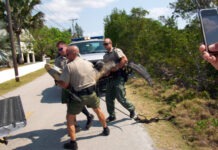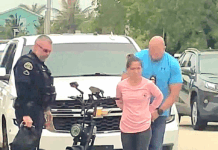Jason Thomason, director of transportation for Monroe County School District, is blunt.
“We need bus drivers,” he said.
He explained that the district currently needs to find 10 candidates to fill the empty bus driver positions. Usually, the district has 50 drivers total to serve the needs of 2,000 students.
The empty positions create a busy day for Thomason. He usually has mechanics fill the vacant slots, or he has to pitch in himself and jump behind the wheel of a bus. He also gets creative with the routes.
“With Sugarloaf School, we had to stagger the schedule, doing first the middle school, then the kindergarten route,” he pointed out. “The middle school route is 7:30 and elementary is 8:30. We’re at half capacity with staff in Sugarloaf.”
But the school bus driver shortage is not only in the Keys, it’s “a nationwide crisis,” as Harry Russell pointed out at a recent school board meeting. Russell is the district’s executive director of personnel support and instructional leadership.
“Nationwide, it’s something that’s been building for a long time,” Russell told Keys Weekly. “We have encouraged kids to go to college, but we’re realizing as a country that there are great jobs that exist without the need of college: electricians, plumbers, truck drivers and bus drivers. We have a great need for these positions, and there’s always a need for people with CDL licenses.”
“A national shortage of school bus drivers that started last year has become so severe that a number of states are taking drastic action, including calling on the help of the National Guard,” said a Forbes article in October. “With the return of in-person schooling, many school districts and bus businesses have attempted to lure back drivers with pay increases and bonuses (one local bus company in Connecticut started offering a $7,000 signing bonus for licensed school bus drivers), and have even started offering money to parents to drive students.”
Russell said the district has discussed giving out signing bonuses but has no plans to do so — yet.
Thomason said the reason for the local crisis is multi-faceted.
“Probably one of the biggest challenges we have is that it has become onerous to get a CDL license,” he said. “But also, too, you have the local culture of the medical use of certain things, and we have random drug testing. That takes out another huge segment of people. Then you throw in the cost of living.”
The work schedule also isn’t for everybody: there’s a shift in the morning of two to three hours, a gap for three hours, then an afternoon shift of three to four hours. Russell said the gap hours in the middle of the day are problematic.
“What we have done is offer bus drivers the opportunity to pick up an extra 25 dollars an hour during that gap,” Russell said. “They can stay in the school and help security or during lunch time.”
Another challenge? Well, the job is just plain difficult.
“Let’s face it,” said Russell. “You have to like kids. Putting 50 kids at your back while you’re facing forward can be a challenge. You’re navigating U.S. 1, which can be very dangerous. And kids can be kids and be mischievous and do their thing.”
But the job has its rewards. Thomason said the pay is among the highest in the state, and Russell said another big reward is, well, kids can be kids.
“Many of these kids, the first thing they see in the morning is the bus driver, and at the end of day, it’s the last person they see. You tell them to have a good evening and do their homework,” said Russell. “There’s no greater reward than seeing kids attain their goals.”
Thomason said those who are interested in applying for a bus driver job can call him directly at 305-293-1400, extension 53400, and ask for Jason.























